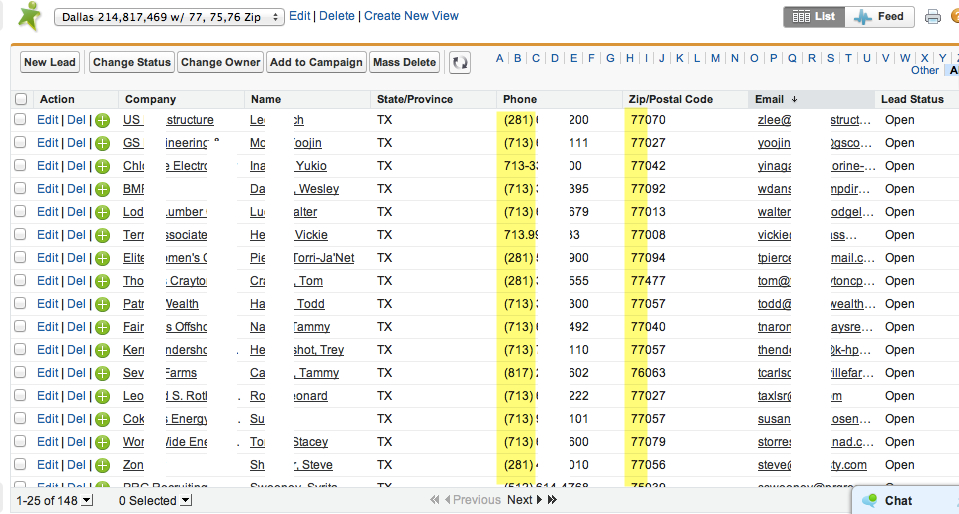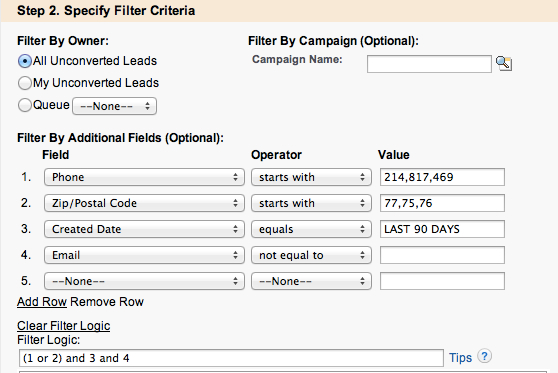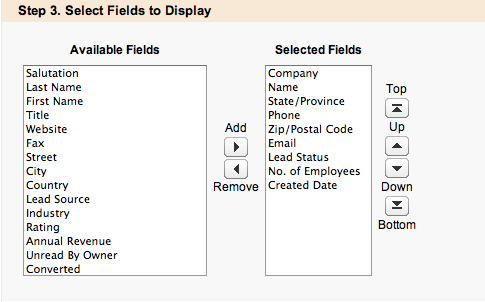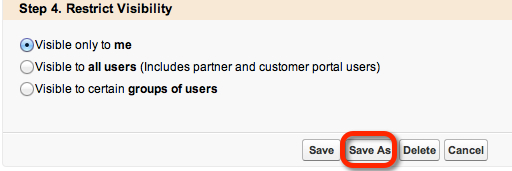Views are available on all tabs (e.g. Leads, Accounts, Contacts, Opportunities, Cases, etc) and are a great usability feature. They allow a user to apply a filter on that Tab to see a subset of records. For example, you can create a View to see:
- All “Open” Leads, created in the last 90 days, that came from our website
- All open Opportunities with a close date of the next 30 days, with a value greater than $10K
- All Contacts in the 214 area code, with VP or CEO in their title
- All Cases, open for more than 21 days that are currently “On Hold”
- All Accounts in Texas that have a zip code that starts with 75, 76, or 77 or assigned to Jack, Aaron, or Margaret
As you can see the variation is quite limitless and it’s one of the things I encourage our clients to leverage to get the most out of Salesforce. So let’s take a look at how to build a custom View. In this example we’ll create a Custom View from the Leads Tab. From the Leads Tab, click the link “Create New View.”
In Step 1 of the wizard we give our View a name. The View Name box is what the user sees when they select a View. The View Unique Name is what the name of the View looks like to the Salesforce database. It must have underscores between words and no punctuation. If you type in a name in the View Name box and then press your Tab key, the system will create the View Unique Name for you.
In Step 2 of the wizard we’re going to specify the Filter Criteria for our View and the process is very similar to writing filters on a report. In the “Filter By Owner” section you must specify how you wants records filtered by user ownership through a radio button selection (i.e. All unconverted, My Unconverted, or if a Queue is the owner of the record you can select the name of the queue).
There is also an option in the top right of Step 2 to select of Leads that have been associated to a Campaign (i.e. Leads that are “Campaign Members” of that Campaign). Very handy if your building a call list on a marketing campaign!
From there we can start picking fields available on the Lead object to help filter and narrow our View. The wizard displays up to five field placeholders, however if you click the “Add Row” link you can have up to 10 field filters.
The middle column is for selecting an operator (the filter logic or action). Here is a list of operators available to you when creating a View:
- Equals
- Not Equal To
- Start with
- Contains
- Does Not Contain
- Less Than
- Greater Than
- Less or Equal
- Greater or Equal
- Includes
- Excludes
- Within
More Tips on how to leverage Operators. Don’t forget you can use literal or relative filters to include “rolling” date ranges!
The far right column is for the Values you want to filter by. You can see that in our example we’ve used commas in between our values, which represents an “OR” statement in the filter. For example on this first field filter our Phone number (Field) must “Start With” (Operator), “214, 817, 469” (Value). The commas between 214, 817, and 469 are really saying the Phone number must start with 214 “or” 817 “or” 469.
Every time you add an additional field filter your telling Salesforce to be more restrictive with your View. If you have a value in row 1, 2, 3, and 4 as in our example you’re telling Salesforce the criteria in Row 1 must be true AND the criteria in Row 2 AND the criteria in Row 3 AND the criteria in Row 4. If that’s not what you want to do, the bottom of Step 2 allows you to change the logic of those rows.
For example, by modifying the filter at the bottom of Step 2 we’re able to tell Salesforce that we want records where EITHER the Phone number starts with either 214, 817, or 469 OR the Zip Code starts with 77, 75 or 76; AND the record was created in the last 90 days AND the record has an email address – as illustrated in the screen shot below:
In Step 3 we can select which fields we want to be displayed in the column headers of our View results. The wizard lets us pick from a list of available fields from the left and then display the selected fields (up to 10) on the right side. The higher the field is on the list to the top, the farther left that column displays on our View.
TIP: As a best practice, if you are filtering on a field in Step 2, display that field as a column in your View so you can spot check that you’re criteria is set properly!
In Step 4 you tell Salesforce if you want this View available to you, or if you can publish the View out to other Users. If your User Profile does not have the “Manage Public List Views” permission, you won’t see the option to publish Views for others users.
Lastly when creating a new view, be sure to “Save As” so you don’t inadvertently save your criteria over an existing View.
When you run your View, you’ll have some additional navigation available. You can sort your list of records by clicking any of the columns headers. Click the column header label once to sort A-Z, or click the column again to reverse the sort Z-A. Sorting works for Date and Number fields as well! You’ll see a small arrow displayed to denote the sort direction applied. 
Additionally, if you are sorting on a column that has text, you’ll see an alphabet “crumb bar” on the top right of your View. If you click on one of the letters of the Alphabet displayed, you’ll only see records where that field starts with that letter.
In our example below we’ve clicked on the Company column, then clicked the letter “H” in our Alphabet bar to filter further and only see Leads where the Company name starts with the letter “H.”
 Having Views set up in your org is a great way to save your Users time and make them more productive!
Having Views set up in your org is a great way to save your Users time and make them more productive!





